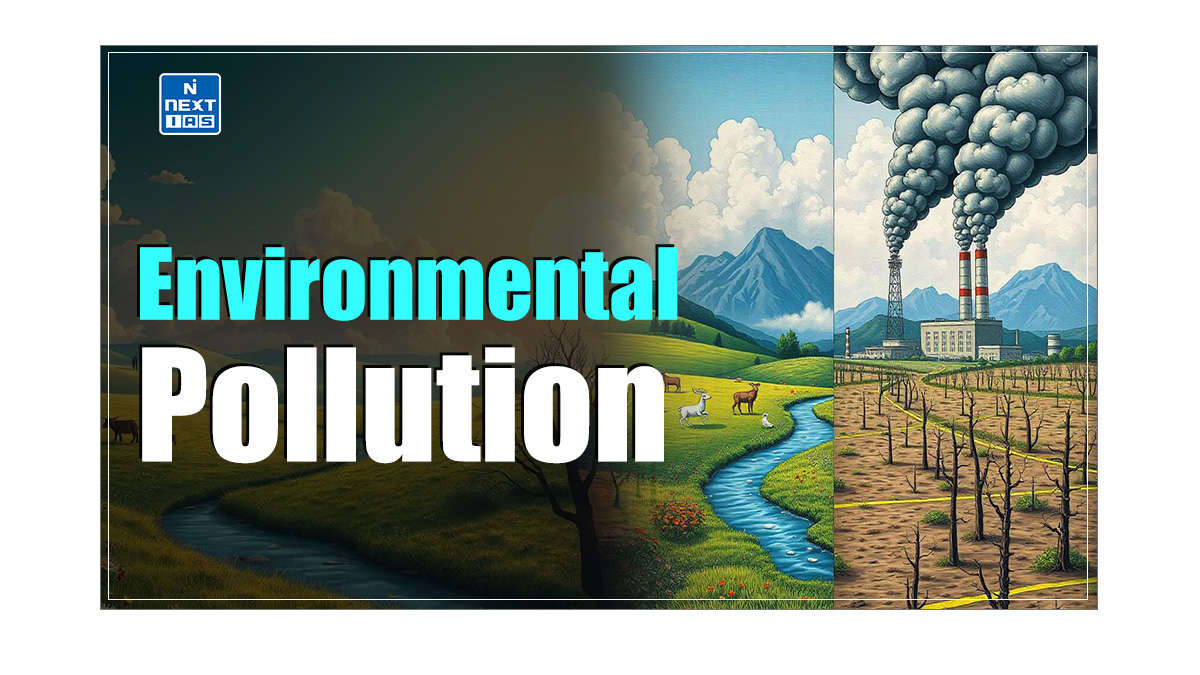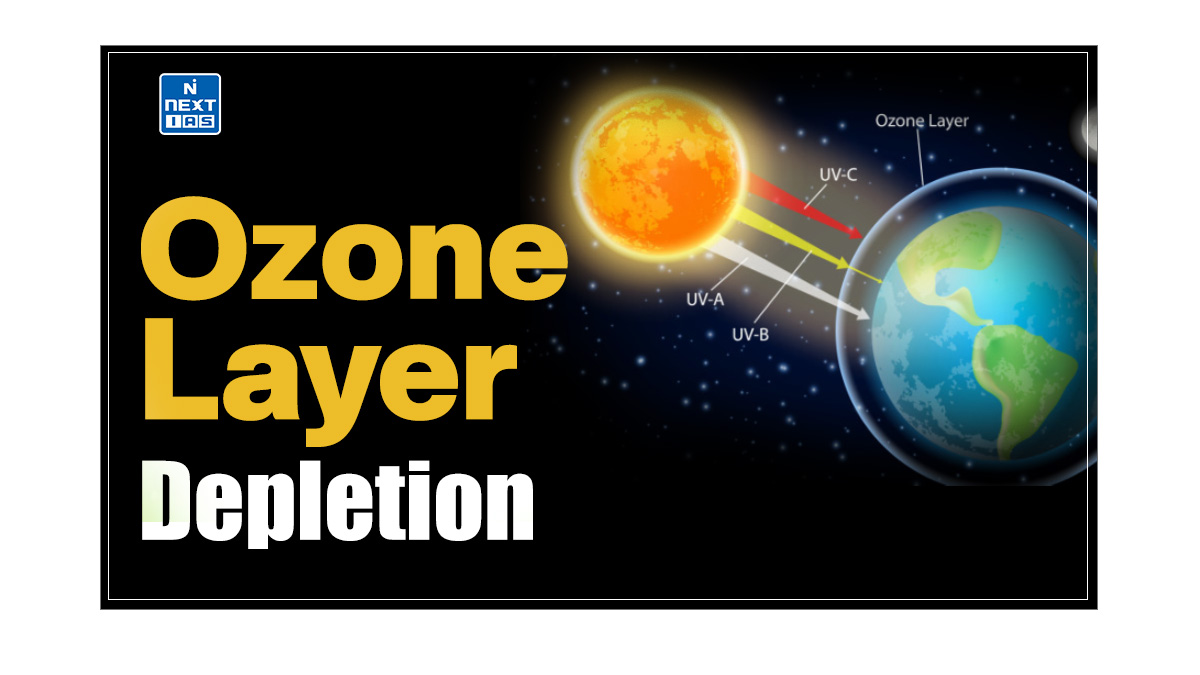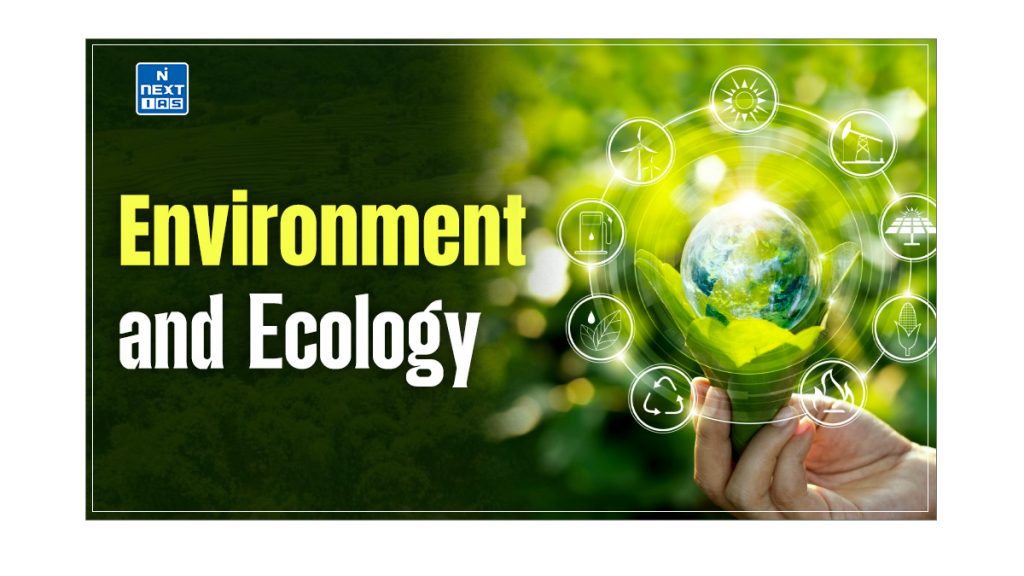
Environment and Ecology play a crucial role in sustaining life on Earth. Understanding the basic concepts related to them is essential for developing a good understanding of this crucial area of the UPSC syllabus. This article aims to study in detail the basic concepts of Environment and Ecology.
What is Environment?
- The word Environment is derived from the French word “Environer”, which refers to the neighbourhood.
- Environment refers to the sum total of conditions that surround us at a given point in time and space.
- Each part of the environment is called an ecological factor.
Components of Environment
The Environment is composed of two components – Biotic and Abiotic.
Biotic Component of Environment
- The Biotic Component of the Environment refers to all the living things in the environment.
- It includes – Human Beings, Animals, Green & Non-green Plants, Decomposers, Parasites, Bacteria, Fungi, Protozoa, etc.
Abiotic Component of Environment
- The Abiotic Component of the Environment refers to all the physical non-living things in the environment.
- It includes – Light, Temperature, Soil, Atmospheric Gases, Weather, etc.
What is Ecology?
- Ecology is the scientific study of the relationship of living organisms with each other and with their environment.
- The term ecology was first coined by the German biologist Ernst Haeckel in 1869.
- It has been derived from two Greek words – ‘oikos’ (meaning home or estate) and ‘logos’ (meaning study).
Note: Environment is the surroundings in which the organisms live. The Ecosystem, on the other hand, involves the interaction between the environment and the organisms living in it.
Levels of Ecological Organization
There are the following 6 levels of organisation in Ecology:
- Individual,
- Population,
- Community,
- Ecosystem,
- Biome, and
- Biosphere
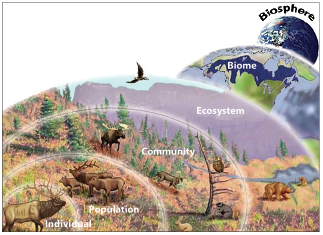
These levels of ecological organisation have been discussed in detail in the sections that follow.
Individual
- An individual is any living thing or organism.
- Normally, individuals do not breed with individuals from other groups.
- The individuals perform all of the life processes independently. For Example, The Tiger (Panthera tigris) is a type of individual organism.
Population
- The population is defined as a group of individuals of the same species, that are present in a specific area at a given time and are capable of interbreeding freely.
- For example, when we say that population of a city is 50,000, we mean that there are 50,000 humans living in that city.
- However, all populations of humans living in any part of the world constitute the species Homo sapiens.
- Every individual species is represented in populations.
Community
- It is a naturally occurring assemblage of species populations that occur together in specific geographical space and time.
- These individuals interact with one of the same species as well as with the other species.
Types of Communities
Based on the size and degree of relative independence, communities may be divided into the following two types:
Major Communities
- A major community refers to the smallest ecological unit that can sustain itself and is self-regulating.
- These are large-sized and relatively independent of other communities.
- They depend only on the sun’s energy from outside.
- A major community is a combination of a floral community, a faunal community and a microbial community.
- For Example, a pond, a forest, a grassland or a lake.
Minor Communities
- Minor communities are smaller ecological units that are not individually self-sustaining and rely on interactions with other communities.
- They make up major communities and are dependent on neighbouring communities for their energy and nutrients.
Structure of Community
- Structure of a particular community means the composition of that community, including the number of species living in that community and their relative numbers.
- Communities may be small, consisting of a limited number of species in a small space, or large, comprising several species populations in a large area.
- Different factors like climatic patterns, interactions between organisms, the density of species, the frequency of disturbances and the abundance of species influence the structure of a community.
Characteristics of Community
Some of the prominent features of a community are as follows:
- Dominance: At each trophic level, one or two species exert more dominance over the function and structure of the community.
- These dominant species impact on the population and activities of other organisms, thus affecting the nature of the community.
- The ecological dominants may change the abiotic conditions of a habitat over a period of time.
- Interdependence: In a community, plants, animals, and microbes have a fundamental dependence on at least one organism, although most organisms will engage in multiple interactions. These interactions can be nutritional, reproductive or protective.
- Stratification: Populations that make up a community are distributed into defined horizontal or vertical strata.
- Some organisms may occupy more than one stratum, moving between the layers on a diurnal basis.
- E.g. a bird feeds on the forest floor during the day, but roosts within the canopy.
- Diversity: It is the variation in the ecosystem of the region or over the whole planet. It considers both the number of species in the community and their relative abundance. Communities with high species diversity have been found to be comparatively more stable.
- Vague Boundary: Communities occur different sizes, and the boundaries of each are often not well defined.
Ecosystem
- An ecosystem is a community of animals and plants interacting with each other in a given area, as well as with the abiotic components of the environment such as air, water, sun, and soil.
- The ecosystem relates to the way that all these different organisms live and interact with each other.
Biome
- Biomes are very large ecological units characterised by a major vegetation type and associated fauna adapting to a specific climate zone.
- A Biome is not an ecosystem, but it can be seen as a form of a massive ecosystem.
- The boundaries and abundance of organisms in a biome are often defined by abiotic factors such as climate, relief, geology, soil and vegetation.
- No two biomes are alike.
Biosphere
- The biosphere is made up of parts of the earth where life exists.
- The biosphere refers to the realm of living organisms and their interactions with the environment, i.e. atmosphere, hydrosphere and lithosphere. It contains all life forms on Earth.
- It is that part of the earth in which many smaller ecosystems exist and operate.
- It extends from the deepest root systems of trees to the ocean trenches, to lush green rainforests and high mountain tops.
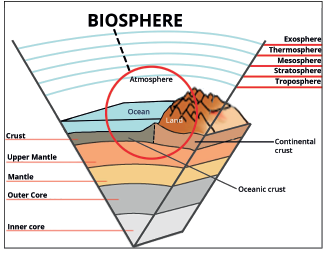
Division of Biosphere
The biosphere is made up of three parts – Lithosphere, Atmosphere and Hydrosphere.
Atmosphere
The term ‘atmosphere’ refers to the layer of gases, commonly known as air, which surrounds the earth.
Hydrosphere
- The water component of the earth is called the Hydrosphere.
- It includes the oceans, seas, lakes, ponds, rivers and streams.
Lithosphere
- Lithosphere is the rigid outermost shell or the hard top layer of the Earth.
- It is made up of minerals and rocks, and is covered by a thin layer of soil.
Ecotone
- An ecotone is a transitional area between two biomes, where communities meet and integrate.
- Ecotones are considered areas of great environmental importance.
- They provide an area for a large number of species, they often experience an influx of animals looking to nest or searching for food.
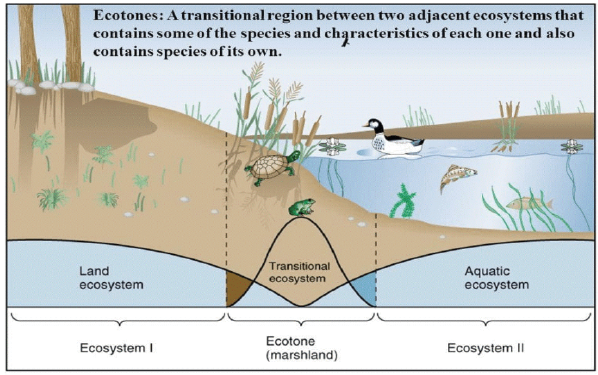
Habitat
- Habitat refers to the physical environment in which an organism lives.
- Each organism has particular requirements for its survival and lives where the environment provides for those needs.
- For example, the habitat of an elephant would be a forest, habitat of a tapeworm is the human gut. Forests, oceans, rivers, etc. are habitats of various organisms.
- The features of a habitat can be represented by its structural components, namely:
- Space,
- Food,
- Water, and
- Shelter or Cover.
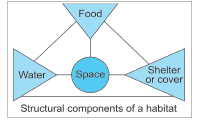
- The Earth has four major types of habitats: Terrestrial, Freshwater, Estuarine and Ocean.
Niche
- A niche is defined as the role a species plays in the ecosystem.
- In other words, it refers to the totality of all the activities and interactions/relationships a species engages in to use the resources in its habitat for survival and reproduction.
- A niche is unique for a species, while many species share the habitat.
- Thus, no two species in a habitat can have the same niche.
- If two species occupy the same niche, they will compete with each other until one is eventually displaced.
Differences between Habitat and Niche
| Dimensions | Habitat | Niche |
|---|---|---|
| Definition | A Habitat is a place or part of an ecosystem where a species live and interact with other factors. | Niche is a role of an organism within its environment or ecosystem. |
| Nature | Habitat is a physical place. | Niche is an activity performed by organisms. |
| Characteristics | It reflects the living place of an organism. | It is about biotic and abiotic association within the environment in terms of its food, reproduction and relationships with other species. |
| Support | Habitat supports multiple species at a time. | Niche supports a single species at a time. |
| Specificity | Habitat is not species-specific. | Niche is species-specific. |
| Relation | It is a superset. | It is a part of habitat. In short, it is a sub-set of habitat. |
| Association | Species with different niches may live in a habitat. | There may be competition from other species for the same niche. |
| Examples | Deserts, Oceans, Forest, Rivers, Mountains | Honeybees gather nectar from flowers to make honey. Other organisms existing in the same environment don’t do it. For example, a bird may live on the same tree as a beehive, but they don’t make honeys as a beehive does. |
Adaptation
- Adaptation refers to the structural, physiological or behavioural characteristic of the life of an organism that enables it to survive in a particular environment.
- Some prominent examples of basic adaptations that help animals and plants to survive in their respective environments are as follows:
- Presence and absence of thorns on stems and leaves.
- Presence of gills and fins in fishes, etc.
Species
- A species is defined as; “a group of similar populations of organisms whose members are capable of interbreeding and producing fertile offspring (children)”.
- For example, the Elephant is an Individual type of organism. Among them, the African elephant (Loxodonta africana) and Asian Elephant (Elephas maximus) are different species.
- Every species has its own set of genetic characteristics that make the species unique and different from other species.
Read our detailed article on Speciation and Related Concepts.
Dispersal
- Dispersal refers to the process by which groups of living organisms expand the space or range within which they live.
- The process of dispersal involves Emigration and Immigration.
Emigration
The movement of individuals of a population out of a region on a permanent basis is termed emigration.
Immigration
Immigration refers to the process of individuals moving into a new area.
Biotic Potential
- Biotic Potential refers to the maximum reproductive capacity of an organism under optimum environmental conditions.
- It is often expressed as a percentage or proportional increase per year.
- Full expression of an organism’s biotic potential is restricted by environmental resistance, i.e. any factor that inhibits the increase in the population.
Biotic Interaction or Species Interaction
- Biotic Interaction, also known as Species Interaction, refers to the various ways in which living organisms within an ecosystem interact with each other.
- These interactions are crucial for the survival and functioning of ecosystems, as they influence the distribution, abundance, and evolution of species.
- Biotic interactions can be classified into several types based on the nature and impact of the interaction on the organisms involved.
Read our detailed article on Biotic Interaction.
Conclusion
The basics of environment and ecology form the foundation for understanding the complex web of life on Earth. From biodiversity loss to climate change, these concepts are vital for addressing many of the environmental challenges we face today.
Frequently Asked Questions (FAQs)
Is Ecology and Environment topic important for the UPSC CSE exam?
Yes, Environment and Ecology subject is very important for the UPSC CSE. Questions from this subject are asked in the UPSC Prelims as well as Mains exams.
What are the important topics to cover in the Environment and Ecology topic for UPSC CSE exam?
Important topics under the Environment and Ecology syllabus for the UPSC CSE include – Basic Concepts, Biodiversity, Pollution, Environmental Governance, etc.

